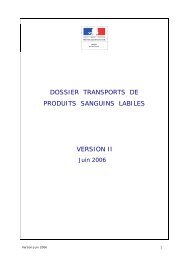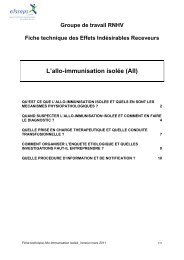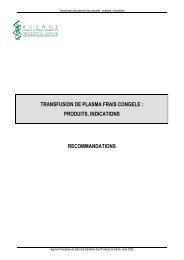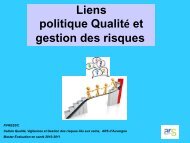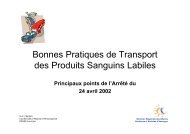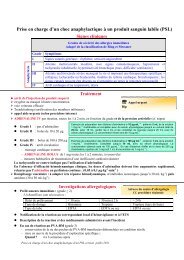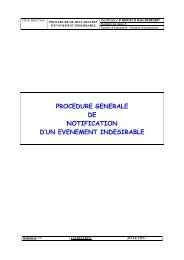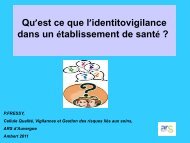Une sentinelle. La gestion des alertes et des risques emergents
Une sentinelle. La gestion des alertes et des risques emergents
Une sentinelle. La gestion des alertes et des risques emergents
Create successful ePaper yourself
Turn your PDF publications into a flip-book with our unique Google optimized e-Paper software.
IXe CONGRES NATIONAL D’HEMOVIGILANCEET DE SECURITE TRANSFUSIONNELLEReims - 8 au 10 décembre 2010UNE « SENTINELLE ».LA GESTION DES ALERTESET DES RISQUES EMERGENTS.LE SYSTÈME DE SURVEILLANCE.Dr Jean-Patrice AULLENCoordonnateur Régional d’Hémovigilance PACAMarseille, ARS PACAReims, le jeudi 9 décembre 2010
HISTORIQUE DES EIGD <strong>et</strong> SIGNAUX (1-1)Collectes, dons dominés par sécurité virale : AFS - CNH 1995-1997Conséquences : Organisation de la collecte, interrogatoiredonneur, <strong>et</strong> sécurité <strong>des</strong> dons (devait être poursuivie par celle <strong>des</strong> donneur)Survenu d’un décès d’un donneur : Côte d’Armor 19971/ Des <strong>alertes</strong> adressées à l’AFSSaPS <strong>et</strong> aux CRH :1.1. Déclaration initiale sur site Haemonétics donneurs deplasma en aphérèse le 21/03/200511 réactions sur forme de flush <strong>et</strong> d’oppression thoracique sur 25 000 donsappareilcédant rapidement dans les 3 à 5 minutes en France. 0 en RFACause = principe acidifiant <strong>des</strong> anticoagulants (citrate à 4%)Suspension demandée à EFS : existence d’alternatives (anciens dispositifssans bol filtrant)Des <strong>alertes</strong> « <strong>sentinelle</strong>s » vers un système de surveillance….(!)
18 FELICIA E. KRUSEembodiment in real things so that they might be recognized in their own right”(50). I want to suggest that <strong>La</strong>nger’s commitment to the doctrine of semblanceprobably accounts largely for her inability to acknowledge the correspondencesb<strong>et</strong>ween Dewey’s account of rhythm in aesth<strong>et</strong>ic form and her own.II. Vital Rhythm as FormativeSince Art as Experience appeared nin<strong>et</strong>een years before Feeling and Form, l<strong>et</strong> usturn first to Dewey’s account of rhythm in that work. To understand this accountit is important to recall one of the central ten<strong>et</strong>s of his aesth<strong>et</strong>ics. What aesth<strong>et</strong>icsstudies is not the art “object,” a thing construed to be ontologically independentof the experiences and activities of creator and perceiver. “In common conception,”Dewey observes, “the work of art is often identified with the building, book,painting, or statue in its existence apart from human experience” (LW 10:9). Butto think of art in this way is to distort the true nature of art and the artwork, for“the actual work of art is what the product does with and in experience” (10:9).It is a “work” in the sense of being constituted by a process of its creator’s (orcreators’) working with the material of his or her art. In so doing the artist worksthrough the initial impulsion that gave rise to his <strong>des</strong>ire to create this work andtransforms the impulsion’s energy consciously and qualitatively “into thoughtfulaction, through the assimilation of meanings from the background of past experiences”(10:66). Thus “the real work of art” is a process, not simply an object; itis “the building up of an integral experience out of the interaction of organic andenvironmental conditions and energies” (10:70). This is true of the role of theperceiver as well, including the artist as perceiver of his own work. It is also trueof how communities “perceive” and incorporate works important to their traditions,such as the Bible or the Ramayana. The act of perception, which is not tobe confused with mere recognition, is at once active and receptive—“an act ofreconstructive doing” in which the perceiver engages in “a series of responsiveacts that accumulate toward objective fulfillment” (10:58–59). The interactiveprocess of creative/reconstructive doing and receptive undergoing is perhaps mosteasily exemplified in the performing arts, as when a soloist creates a performanceof Bach’s unaccompanied Cello Suite No. 1 in G major. The performance is aninterpr<strong>et</strong>ation of the Bach suite, but it is at the same time an actualization—abringing into being—of the music itself. 3 But analogous processes are involvedin the creation and perception of artworks in any genre. “The real work of an artist,”Dewey maintains, “is to build up an experience that is coherent in perceptionwhile moving with constant change in its development” (10:57).The dynamic nature of the artwork is rooted in the temporal quality of allaesth<strong>et</strong>ic experiencing. A distinctly aesth<strong>et</strong>ic experience consists in “conversion of
EIGD <strong>et</strong> SIGNAUXHISTORIQUE DES EIGD <strong>et</strong> SIGNAUX (2)2/ Des messages adressés à l’autorité de tutelle administrative(25/07/2005) :« 3 évènements récents ont concerné l’hémovigilance donneur :. Kits Haemonétics Plasma. Kits Haemonétics Plaqu<strong>et</strong>tes. Epidémie à CHIK (Océan Indien) <strong>et</strong> personnes susceptiblesd’être donneur en France »« Ces expériences amènent-elles <strong>des</strong> changements sur lafaçon dont était perçu le problème jusqu’alors …dansle domaine de l’hémovigilance donneur ? »Des <strong>alertes</strong> « <strong>sentinelle</strong>s » <strong>et</strong> …une cultureConclusion = <strong>des</strong> <strong>alertes</strong> « <strong>sentinelle</strong>s » <strong>et</strong> …..culture
EIGD <strong>et</strong> SIGNAUXHISTORIQUE DES EIGD <strong>et</strong> SIGNAUX (3)3/ Des rapports <strong>et</strong> <strong>des</strong> indications partagés avec le réseau(mais aussi sur le rôle <strong>des</strong> établissements de santé) <strong>et</strong> mis surle site intern<strong>et</strong> à votre région PACA3.1. Des résumés annuels de chacun <strong>des</strong> EIGD (2007-2010)3.2. Des interventions sur la mise en place d’une fiche de recueil(FEIGD) en référence à un système de surveillance, car« incomplète, non cohérente », inexploitée automatiquement3.3. Des rapports successifs 2007-2010 transmis aux échelonslocaux <strong>et</strong> nationaux <strong>et</strong> <strong>des</strong> interventions à propos- du suj<strong>et</strong> principal : jeune femme donnant en aphérèse en site fixe- <strong>des</strong> signes cliniques à prendre en compte (mal définis <strong>et</strong> incompl<strong>et</strong>s)- incomplétude <strong>des</strong> enquêtes, car suivis, explorations <strong>et</strong> traitementspeu documentésDes <strong>alertes</strong> « <strong>sentinelle</strong>s » <strong>et</strong> …une cultureConclusion = <strong>des</strong> <strong>alertes</strong> « <strong>sentinelle</strong>s » <strong>et</strong> …..culture
EIGD <strong>et</strong> SIGNAUXHISTORIQUE DES EIGD <strong>et</strong> SIGNAUX (4)4/ Des interventions, <strong>des</strong> questionnements <strong>des</strong> acteurs <strong>et</strong>de l’institution en charge, <strong>et</strong> de la commission nationale del’hémovigilance (juin 2009)5/ <strong>Une</strong> synthèse dressée <strong>et</strong> exposée en novembre 2009 auxCRH (Aullen - Daurat - Mansard) <strong>et</strong> aux différents niveaux del’autorité, ainsi que <strong>des</strong> propositions d’axes d’actionscorrectrices <strong>et</strong> préventives à m<strong>et</strong>tre en placeDes <strong>alertes</strong> « <strong>sentinelle</strong>s » <strong>et</strong> …une cultureConclusion = <strong>des</strong> <strong>alertes</strong> « <strong>sentinelle</strong>s » <strong>et</strong> …..culture
EIGD d’imputabilité = 2 <strong>et</strong> 3 : Des Faits <strong>et</strong> ….<strong>des</strong> manquesEIGD D’IMPUTABILITE 2 <strong>et</strong> 3 : exemple PACA 2009Des faits <strong>et</strong> <strong>des</strong> manques• Sur-représentation féminine• sexe ratio F/H = 2 en aphérèse• sexe ratio F/H = 2,4 en sang total• Risque EIGD : 8 x plus élevée femme (aphérèse) / homme (sang total)• Aphérèse : taux 3 fois plus élevé qu’en sang total• 1 er don : 1,5 fois plus élevé que chez donneur connu• Site fixe : 3 fois plus élevé qu’en collecte mobile• <strong>La</strong> moitié : hors <strong>des</strong> lieux de prélèvements• Perte de connaissance : 39%• Malaise vagal : 22%• Mais aussi hypotension majeure <strong>et</strong> convulsions• Complications : 20% <strong>des</strong> casDes faits, <strong>des</strong> <strong>alertes</strong> « <strong>sentinelle</strong>s », un système d’information, une organisation<strong>et</strong> …une culture
HEMOVIGILANCE DONNEUR <strong>et</strong> SECURITESécurité <strong>des</strong> donneurs <strong>et</strong> de la collecteGestion <strong>des</strong> <strong>risques</strong> :- Pratiques professionnelles en aphérèse/Appareils liés aux kits<strong>et</strong> aux solutés/catégories de donneurs- Limites <strong>des</strong> « extractions » lors de chaque type d’aphérèse- Limites du don, même en sang total- Les autres EIGD / type de donAgir :- Revaloriser le rôle <strong>des</strong> acteurs de la collecte par rapport auxautres acteurs de l’institution tels ceux de l’IHR <strong>et</strong> la délivrance- Rôles <strong>et</strong> missions vis à vis <strong>des</strong> divers fabricants réunis<strong>La</strong> sécurité du donneur : priorité, de la <strong>gestion</strong> <strong>des</strong> collectes<strong>et</strong> <strong>des</strong> dons. Nécessité de son suivi.Prévention de l’état de santé <strong>et</strong> du « bien être » du donneur.Culture : Un donneur n’est pas un patient. Il n’est pas pensable qu’il puisse êtremis en danger <strong>et</strong> surveillé « comme un patient »…alors que les faits, rien que lesfaits <strong>et</strong> l’évolution <strong>des</strong> techniques indiquent le contraire.
HEMOVIGILANCE DONNEUR <strong>et</strong> SECURITEPropositions de novembre 2009 …..à décembre 2010Mise en place d’un plan d’action par l’EFS :Surveillance clinique <strong>et</strong> paraclinique <strong>des</strong> donneurs (à compléter).Information <strong>des</strong> donneursOrganisation. de la sécurité de la collecte (habilitation <strong>des</strong> sites en cours). de la réponse en cas d’EIGD sévère, lien avec les urgencesRôle de l’EFS <strong>et</strong> <strong>des</strong> établissements de santé (à consolider)Investigations dirigées (guide d’exploration) lors de pertes deconnaissances, signes cardio-vasculaires….Enquêtes épidémiologiques : malaise vagal, explicitations de la surreprésentationféminineOrganisation de la préventionUn système incompl<strong>et</strong> sur le plan de l’information (qui donnait pourtant <strong>des</strong>signaux ) <strong>et</strong> de son organisation ; Mais sans actions correctrices <strong>et</strong> préventives« suffisantes ». Il peut être encore amélioré.
Signaux <strong>des</strong> <strong>sentinelle</strong>s <strong>et</strong> Prises en compte :Quels devenir <strong>des</strong> uns <strong>et</strong> <strong>des</strong> autres ?Comment <strong>et</strong> à quelles conditions peuvent- émerger les vrais signaux,- être dépassés pour la mise en œuvre, les obstacles. Conditions techniques. Poids institutionnels de plus en plus prégnants. Dualité médiatique <strong>et</strong> Efficience professionnelle. Poids du judiciaire <strong>et</strong> du réglementaire. Partage <strong>des</strong> responsabilités institutionnelles <strong>et</strong> extrainstitutionnelles avec les acteursMise en route <strong>des</strong> plans d’actions partagésParticipation <strong>des</strong> donneurs, <strong>des</strong> associationsRé-émergence <strong>des</strong> assurancesImplication <strong>des</strong> acteurs, <strong>des</strong> instances professionnellesLutte contre la marginalisation institutionnelle <strong>des</strong> <strong>sentinelle</strong>s,Protection <strong>et</strong> mieux Promotion <strong>des</strong> <strong>sentinelle</strong>s dans le système français(parcellisé)Conclusion = Culture : Totems - Tabous <strong>et</strong> Sentinelles.Nécessités : vraie reconnaissance professionnelle institutionnelle: voire protection <strong>des</strong> <strong>sentinelle</strong>s par une instance indépendanteRisque majeur : immobilisme <strong>des</strong> institutions <strong>et</strong> <strong>des</strong> systèmes
UN TRAIN PEUT EN CACHER UN AUTREPLASMA BMOctobre novembre 2009EFFETS INDESIRABLESGRAVESDONNEURSRegarder Ecouter AgirReconnaître Valoriser Protéger les <strong>sentinelle</strong>s





